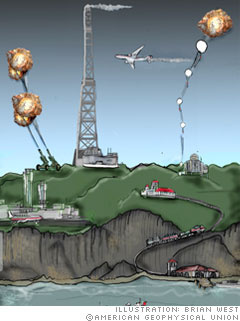
How it works: Volcanic eruptions have shown that putting sulfur in the atmosphere cools the planet. Rain drops react with the sulfur particles high in the stratosphere, forming clouds that keep out sunlight.
The clouds are thin, so the sky would be less like London and more like a hazy day at the beach.
The sulfur is cheap, and comes from an activity we're well versed in: burning oil and coal. It could be delivered into the stratosphere by high flying jets, artillery, or hot air balloons, pictured here.
Another idea is to deliver the sulfur to the stratosphere via an extremely long hose kept aloft by a series of balloons. This method is said to be cheaper than others.
Why it might not work: A major downside is what effect this could have on rain patterns, said Alan Robock, an environmental sciences professor at Rutgers University. It may disrupt the monsoons in Asia, rains that sustain food crops for billions of people.
And like most geoengineerng schemes, it would need to be done continuously, for as long as carbon levels stayed high, or else the earth would rapidly warm up again.
NEXT: Carbon-sucking machines
